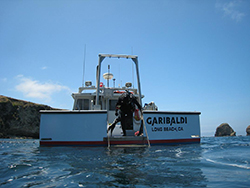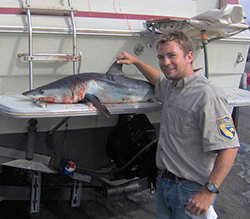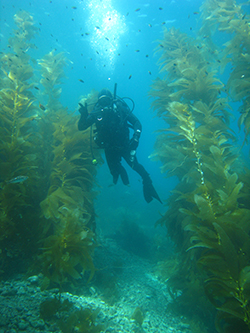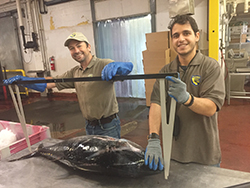
Travis preparing for an abalone survey dive, Catalina Island. Photo credit Derek Stein, CDFW

Travis working on the California Recreational Fisheries Survey, San Diego. Photo courtesy of Travis Buck

Travis at a CDFW scientific diver recertification training, Catalina Island. Photo credit Colleen Wisniewski

Travis and Scientific Aid Nima Farchadi collecting Pacific Bluefin Tuna biological data, San Diego. Photo credit Erica Mills, CDFW
Travis Buck is an environmental scientist with the CDFW Marine Region’s Highly Migratory Species and Ecosystem Management Project in San Diego. His primary responsibilities include data collection and analysis for highly migratory species and representing CDFW on the Pacific Fishery Management Council’s Ecosystem Workgroup.
A Midwest native, Travis moved to California in 2003 after receiving a degree in Geography with an emphasis in Environmental Studies from Ohio University. He also completed Tropical Marine Ecology graduate level coursework in Florida and the Bahamas.
What led you to a career in marine biology?
I became fascinated with the ocean and the creatures that inhabit it at an early age. I remember my grandfather used to take me fishing in Florida and that was always very exciting. I especially liked the idea that you never knew what was on the end of your line until it surfaced, and so I began identifying fish as a kid on those trips. I was a big fan of aquariums too, and when I got a little older I became really interested in snorkeling, freediving and exploring reefs in Florida and the Bahamas. It seemed to be a more serene, foreign world, and I wanted to live closer to it and understand the life that existed within it.
In school, I also excelled at math and science, so marine biology seemed like a natural fit. I have an aunt who jokes that I told her when I was five years old that I was going to be a marine biologist. She can’t believe I followed through with what I said at such a young age.
What brought you to CDFW? What inspires you to stay?
I began my career with CDFW in 2007 after three years as a contractor working on the California Recreational Fisheries Survey (CRFS). For the first 10 years of my career, I worked for the Marine Region’s Invertebrate Management Project, primarily on research and management of the spiny lobster fishery. I recently transferred to the Marine Region’s Highly Migratory Species and Ecosystem Management Project to expand my knowledge of marine fisheries.
I think the mandate of CDFW is a pretty epic one, to ensure that California’s natural resources are there and are healthy for future generations. I can’t really think of a responsibility more noble than that. When I look back on the almost 15 years I’ve been associated with CDFW, it’s almost impossible to fathom how much I have learned, and also how much of the state I’ve been able to see through being employed here.
What is a typical day at work like for you?
It might be crunching numbers to track Pacific Bluefin Tuna landings (since they are managed with a quota), or it might be assisting scientific aids with dockside sampling questions, or it might be traveling out of state for a Pacific Fishery Management Council meeting, or a plethora of other duties. Issues with natural resources are dynamic and always changing, and so are the assignments at CDFW. I think most environmental scientists working for CDFW will tell you that there’s no such thing as a “typical day,” and that’s another reason that keeps me here, there’s not a lot of repetition of tasks. You’re constantly learning new skills.
What is the best thing about your job?
I love being at the forefront of marine-related research and being “in the know” about major issues affecting the ocean and its fisheries when sometimes the majority of the public aren’t even aware. And it’s not only about the major issues affecting the ocean, but also the cool discoveries. My job provides the opportunity to act as a messenger, to disseminate these cool discoveries, as well as important problems, to a wider audience.
Diving at the Channel Islands over the years for CDFW, particularly the abalone surveys, provided some of the best memories I’ll ever have. Some of the things I saw underwater were so amazing and surreal. For instance, after one survey at Catalina Island, as we were slowly ascending to the boat, it started to rain. A school of barracuda were above us, and we could see raindrops breaking the ocean’s surface right above them while we hung out in the kelp forest for our safety stop. Scenes like that I’ll never forget. And all the people I’ve been able to meet and work with. Wow, it’s kind of mind-blowing looking back at how much information and how many people and places this type of work can expose you to.
What is the accomplishment you’re most proud of?
I’m proud of the work I did to successfully develop and manage the lobster report card program. Before lobster report cards, which gather data and are required for lobster fishing, we had no idea how large the recreational fishery was for lobster, or how much lobster that sector landed each year. Now we have a much better grasp on that information. Also, I’ve enjoyed writing two articles for Outdoor California magazine that detailed CDFW research on abalone and lobster. Writing is a passion of mine.
I’m also proud of becoming a CDFW diver. I passed the entry examination with only the bare minimum number of required dives under my belt. It was very physical, with underwater breath-holding exercises in the ocean that are pretty difficult. I was pumped when I completed those.
What interesting projects are you working on currently?
I’m really interested in the work my project is doing with Pacific Bluefin Tuna. Not only do I track the total landings of this species in California, but we recently began collecting genetic samples of Pacific Bluefin Tuna landed in San Diego, which could give us further insight into the population being targeted by offshore fishing here. Pacific Bluefin Tuna were so heavily fished over the last century by other countries, the population is at a small fraction of its historic levels. There are real efforts being made at the international level to rebuild the population, however. That’s a good thing.
If you had free reign and unlimited funding, what scientific project would you most like to do?
I would organize a giant collaboration to better understand how the combination of warming ocean temperatures, increasing ocean acidification, and increasing hypoxia (like we are seeing take place around the world) will affect all of the commercially and recreationally important marine species off the U.S. West Coast. Humans need to know these things, so we can prepare for a rapidly changing world.
Do you have any advice for people considering careers in science or natural resources?
Work on your math and writing skills! There are a lot of numbers involved, and there is a lot of writing involved. Also, natural resource management actually involves managing people, since we are the ones exploiting the natural resources. So, work on your interpersonal skills – you’ll need them!
Tell us something about yourself that people might be surprised to learn.
I love surfing. I’m obsessed with everything about it! I’m convinced it’s the most beautiful, healthy and rewarding passion there is. I’ve also survived two boat crashes! Honestly, I have. Both were research trips, and neither was the fault of the researchers on board!
CDFW Photos. Top Photo: Travis with a yellowtail, San Clemente Island. Photo courtesy of Travis Buck.